Today we are going to talk about specific obstacles that the beginner faces in Meditation practice. There are many obstacles to Meditation, and in the previous lectures we pointed out some of the most fundamental ones:
- Not knowing what the Consciousness is, and not knowing how to work with it. We all have ideas about Consciousness, but we need to know experientially in the moment what it is and how to use it. Refer to previous lecture to build upon this: Meditation Essentials 02: Consciousness
- Lack of energy. Usually, we do not have energy, because we have wasted energy, we have squandered it; we have invested it into harmful action. We need to learn how to save, accumulate, and transform energy in order to nourish our Consciousness daily. That is why gave this lecture: Meditation Essentials 03: Energy
- Committing actions that impede Meditation. We tend to act in ways that contradict our spiritual goals. We need to set up the prerequisites for good practice; we need good ethics; we need to know how actions lead to consequences that if we behave in certain ways, certain consequences always result, and our ignorance of that is a big obstacle for us. That is why gave this lecture: Meditation Essentials 04: Action and Consequence
In today’s lecture we are going beyond those preliminary obstacles. Now we are going to talk about obstacles the arise when we are practicing: either doing our preliminary exercises or in the actual practice of Meditation.
We previously explained that the state of Meditation is a precise state of Consciousness that we access when we learn how to harness concentration and imagination at the same time, together. To do that requires training, so most beginners start with developing concentration first.
Preliminary Training of Concentration
In the first six lectures of this course we have encouraged you to practice daily:
- Self-observation
- Concentration
Self-observation is mindfulness of one’s actions. It means to always be aware of yourself, to be present, to be in the moment, to be aware of your body, to be aware of your heart, to be aware of your mind, and to be cognizant of what you are doing at all times. That is the first exercise and that exercise establishes the very beginning of Meditation. If you are not doing that, you will never learn to meditate.
The second exercise is to develop your concentration daily by doing preliminary concentration practices. An easy practice for this is the observation of the sensations of the breath. If you have been following this course you would have been doing these exercises now for twelve or fourteen weeks.
Now we are going to go into a new phase of work, where we are going to leave behind the preliminary exercises and go into something that is perhaps more difficult but also incredibly important: visualization.
Deeper Training of Concentration
Concentration, serenity, is a state of Consciousness, it is an action of Consciousness, and it utilizes energy. Do you see those factors there?
- Consciousness
- energy
- action
We need to be very aware of that trinity. That power of three creates, and it will create in accordance to the action.
We are learning to concentrate our Consciousness by using energy in a right way; the result is serenity. The result of using those three in harmony is that steadily we begin to advance through the nine stages of serenity that we explained previously. That happens because of a cause and effect process; it does not happen by beliefs, theories, or as a gift from the gods.

The Nine Stages of Meditative Serenity
Serenity is a result of how you put your Consciousness and energy into action. That is all that determines your progress through the stages of concentration. This means that if you are not experiencing a change in your concentration, it is simply because you are not yet producing the cause that creates the result you want.
The Defining Characteristics of Concentration
In this tradition we learn that concentration as a state of Consciousness has two important features that we need to be able to identify in our practical experience, specifically in Meditation practice. Those two distinguishing features are:
- Vivid intensity, intense mental clarity
- Stability, one-pointedness
Stability, one-pointedness, is the ability to remain focused on something without wavering.
Vivid intensity is visual, imagery, that is something perceived; it is not imaginary, this is not just metaphorical. This means that real concentration is a form of visual perception. Thus, to develop real concentration, one must use visual imagery. This underscores the fact that most practices that people call “Meditation” are actually just preliminary training exercises for relaxation or the very beginning of concentration. Real concentration utilizes the full power of the Consciousness, whose very nature and function is the perception of imagery.
The words “clarity” and “vivid” indicate the ability to perceive something without any obscurity. If I ask you to remember what you had for breakfast, an image pops up in your memory and you can perceive that, even if its only for an instant. How clear is that image? How vivid is it? Can you sustain it without being distracted? The qualities of that recollection are a reflection of your concentration ability. If that image is dim, fleeting, and hard to perceive, then you have work to do.
All of us have the ability to perceive non-physical imagery; we call it imagination or visualization. You can also call it clairvoyance; it is the samething. This is simply the ability to perceive images without the physical senses. That is a power of Consciousness. It is developed by establishing strong concentration and serenity. When your psyche is very calm, this ability to perceive without the physical senses is enhanced, it is much more vibrant. When you have a lot of energy available to that conscious perception, the imagery is even more intense. So if you do not have good concentration or energy, visualization seems impossible. For most people who try to learn to meditate, they cannot do this on day one so they give up; they think: “It is impossible, I cannot do it.” Anyone can do it. Visualization and concentration are natural abilities of the Consciousness, but you have to restore the environment within which they can function properly. That means we first must clear away the initial obstacles that we mentioned previously. We also must work with Consciousness, conserve energy, put it into right action, and improve our ethics. It is through that process that concentration and visualization are able to flower and develop properly.
In our exercises, these are the qualities we need to be looking for, as we develop concentration:
- Vivid intensity, intense mental clarity
- Stability, one-pointedness
As a beginner, you will not have these qualities yet. So, do not expect to have them, but understand that if you practice Meditation in the right way you will develop them.
You will also note that when you are observing the sensations of your breath or some other physical phenomenon, you cannot develop visualization. That is why in this phase of developing concentration it is better to drop those kinds of practices. It is more effective to use practices that harness the power of the Consciousness to imagine. So, as an example, we will observe an image and then we will close our eyes and visualize it.
A Visual Object of Concentration
Look at this picture, then close your eyes and imagine it.
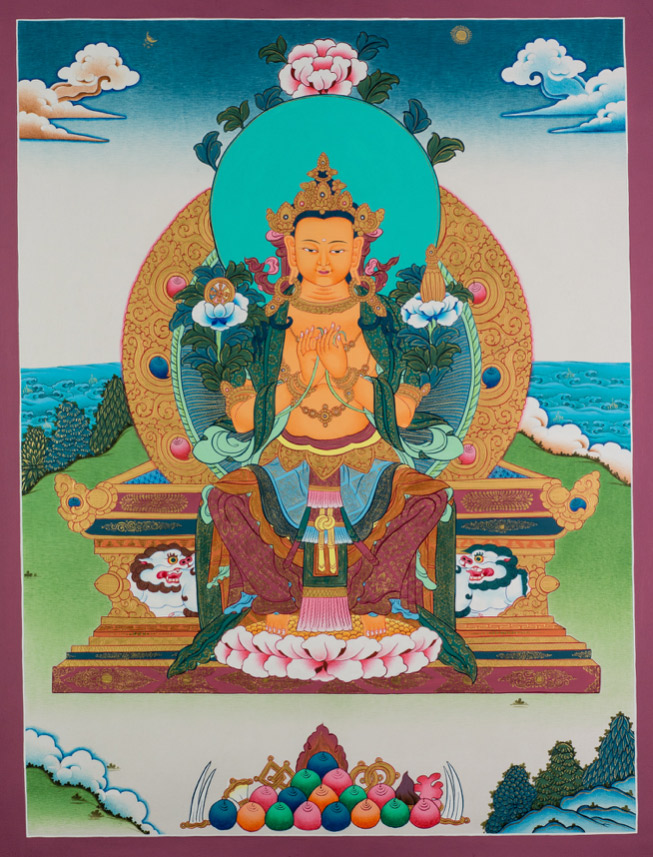
Evaluate your mental clarity and one-pointedness. Can you perceive the image in your visualization? If you can, how long can you hold it before you become distracted, before it fades to black, or before something else appears? How long can you hold this image in your imagination clearly, vividly, and stabilized? That is a measure of your power of concentration and visualization.
If you have developed this ability in yourself, you can hold this image for as long as you want, clearly and vividly. The Consciousness has that power naturally and spontaneously; it is not something supernatural.
Why is this important? This skill is what opens the door to real Meditation.
We explained in the earlier lectures that our goal is Prajna (profound wisdom). We need insight into our suffering; we need to understand why we suffer; we need to understand why things are the way they are. The causes are deep in our psyche and they are very difficult to perceive in our current psychological state, but if we harness the powers of the Consciousness to concentrate and visualize we can access a state of perception called Samadhi. Samadhi is the doorway to Prajna, wisdom.
Samadhi means ecstasy, and refers to a state of Consciousness when it is liberated from all conditioning factors, such as the physical body, pride, fear, lust. In Samadhi, the Consciousness perceives perfectly, clearly, without filters, and it sees what is real; it sees the truth. If you have that power, you can then observe what is causing you to suffer, and instead of responding to it with aversion, fear, regret, remorse, pain, resentment, pride, etc. you can observe it as it is, and you can see why it is what it is, and you can comprehend your karma, and you can understand how to respond, how to change it. That is a tremendous power. That is the power that allows an animal like one of us to become a human being, to become a God, to become a master. It is that power to see the truth and to respond consciously and appropriately. This ability to be able to visualize something and see it clearly without reaction is the foundation that introduces us into the next level of practice, which is the level we need. So it is a very important skill to have.
There are many objects you can use for concentration, but to develop this ability to analyze reality, we need the power of visualization, and that is why for real practice, for real preparation we need to abandon concentrating on physical things and learn to develop the ability to visualize and sustain an image. It is harder, but the result is orders of magnitude more powerful than the ability to observe your breath. Once you have this ability, you will then be able to meditate on anything and acquire information about it; that is really why we want to learn to meditate: to retrieve knowledge for ourselves, not having to rely on anything but our own abilities.
The Early Stages of Developing Concentration
When we begin developing concentration, we pass through these stages.
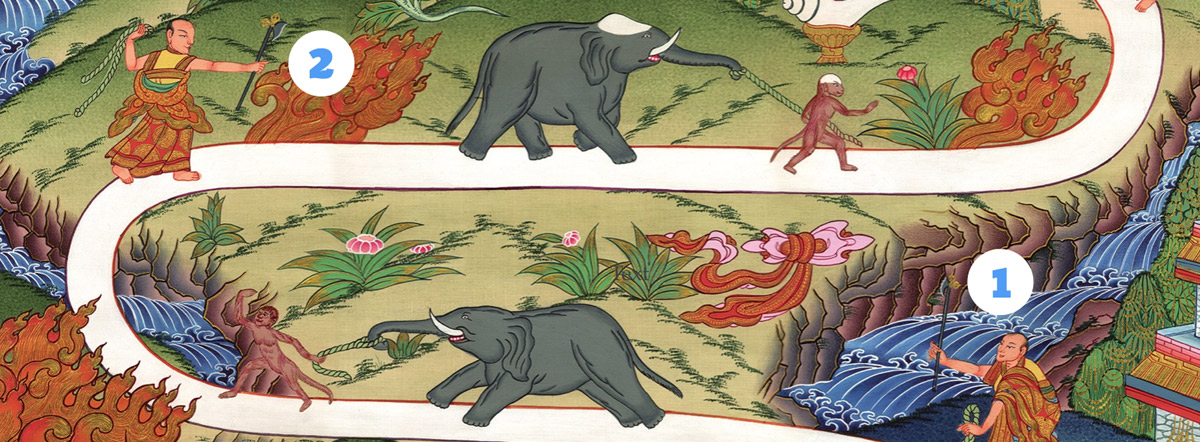
Stages of Tight Focus
- Settle the psyche. Achieved through “hearing.”
- Settling continually. Achieved through “reflection.”
As a beginner, we have a completely wild mind. We sit in our posture, we relax, we try to place our attention on the object of concentration, but we are constantly distracted; the mind and body refuse to cooperate. We are distracted by pain, discomfort, agitation, we want to leave, we want to get up, we want to drink some water, or whatever.
In stage one we encounter constant battles, while we settle the psyche, and that is illustrated by this monk, who is chasing the animals. The animals represent that quality of mind that is always distracted, always seeking things, not settling down. But with some willpower, with study, with learning about the teachings, we can advance to the second stage. That is why this is called “achieved through hearing.” Hearing means that we start to really listen to the instructions about how to concentrate, we reflect on it, and during the effort to meditate, as much as we get distracted, we keep reminding ourselves, “This is the way it is.” Not to get frustrated, not to get discouraged, but to keep remembering the teachings, “I have to place my attention again, I have to place my attention again.” So it is hearing in yourself the instruction. Doing that repeatedly, making that effort every day to practice, ten or twenty minutes a day, little by little, as you work with your Consciousness all day long, and as you save energy all day long, and you act appropriately all day long, you start to move to stage two, which is settling continually. That simply means that now when you practice your concentration exercise, your attention is remaining steady for a little bit longer. The mind and the heart start to settle down a little bit.
Together these two are called “stages of tight focus,” or “forcible engagement.” That means that it takes a lot of effort to continually return attention to the object of concentration.
The second phase is achieved through “reflection,” meaning that you are starting to reflect on that teaching more, you are starting to really digest it, you are starting to reflect on how you see how the concentration is starting to strengthen, the mind is starting to settle, and you are seeing a little benefit. You are starting to reflect on what you are learning.
These two stages of development are difficult, they are hard, there is no getting around that. That is just how it is. Go into to it knowing that. Go into it prepared, and go into to it knowing that this is where you are going to face obstacles. This is where you will be challenged, and most people quit; it is a sad fact. Most people give up. Anyone can learn to meditate, but you need to educate yourself about how to do it, and you need willpower to properly do it. If you are able to understand the teachings and to recognize the obstacles, then you can apply the antidotes to them.
Faults That Prevent Serenity
Here are the main faults that people deal with in these initial phases.
- Laziness
- Forgetting the instructions
- Not recognizing agitation and dullness
- Not applying antidotes
- Over-applying antidotes
If you can recognize these obstacles while you are practicing, you can overcome them. These are the only obstacles you will face. This is it; they are not that difficult.
We are actually really lucky: if you are able to learn Meditation and practice Meditation, and these are the only obstacles you have to deal with, you are very lucky. Most people in the world right now do not have this opportunity. There are people with very difficult, painful circumstances, who wish they could develop their spiritual lives, but they do not have access to the teachings, they live in a place that is not conducive to practice, they may live in places where there is war or they are being heavily persecuted and have no freedom. So for those of us who are able to listen to these types of studies and put them into practice, we are extremely fortunate. And if we quit, we are foolish.
Laziness
The tendency to avoid practice. Caused by:
- Defeatism
- Attachment to harmful actions
- Lack of will
Antidote: Cultivate faith: contemplate advantages of serenity, and disadvantages of distraction
The first fault, and the most common, is laziness. This is simply to avoid practicing Meditation, or doing spiritual practice in general. We have all kinds of excuses for it, we justify it, but really laziness is just that.
The first cause of laziness is defeatism; that is when we tell ourselves, “I cannot do it, I am not capable, my mind is too crazy, my karma is too heavy, my circumstances are terrible. I do not have a spouse, a teacher, a school, spiritual friends, etc.” We have lot of excuses, but none of them are true. All of them are the ego fighting to preserve itself.
Our ego does not want to give up control over our energy and Consciousness, and it uses that type of thought process to disempower the Consciousness, to disempower the soul. We as a soul, as a Consciousness, need to recognize laziness for what it is, especially defeatism; defeatism is poison. We should never allow defeatism in our thoughts, feelings or actions, even as a joke, even when we are talking with other people, such as saying, “I am not capable of meditating, I cannot do it.” That is very negative and infectious.
The second cause of laziness is attachment to harmful actions. We may know a lot about the teachings, we may love spirituality and dharma, we may study everything, but we remain addicted to gossip, negative tv, alcohol, drugs, smoking, masturbation, or other types of actions that are directly contradictory to our spiritual goals. In other words, we have an addiction or an attachment to actions that prevents us from practicing in a right way.
If we are having struggles with our Meditation, there is a cause; if we are having difficulties, if we are feeling sour about our practice, we are feeling like it is impossible, the cause is not the practice, the cause is not the teaching, the cause is our psyche, something in our mind. When someone feels negative towards their Meditation practice, it is because they are doing something wrong. When we feel that, we need to identify the cause.
Sometimes it is a lack of will, which is the third cause. To have a lack of will means that even though we may be interested in the teachings and value them, we do not have the zeal needed to actually put them into practice. We lack full comprehension of the reality. When you comprehend the reality, you immediately have great zeal, willpower. This is like someone who suddenly realizes they are in a house that is burning down: that recognition of the truth provokes immediate action.
All of these forms of laziness can be dealt with in the same way, but the first thing we have to do is to recognize them and immediately apply the right antidote.
In general, laziness is overcome by cultivating faith, which is multifaceted. We do not mean faith as belief; we mean faith in its original meaning, which is confidence through experience. Real faith is having knowledge through experience, confidence, because you have proven that the teachings work. The way we cultivate faith in these teaching is we put them into practice and measure the results. When you acquire results, then you know for yourself that it works; you have to reflect on that, become conscious of that and recognize: “I did this and that, and I got these results, and it does work.” That builds faith. What happens when you build faith? You build confidence. When you build confidence, you build diligence; you are willing to work hard because you know it works. This is how you overcome laziness; it is simple.
The other thing about overcoming laziness is to contemplate the advantages of serenity or concentration. When you notice that you are unwilling to practice Meditation, you need to sit down and really talk to yourself, talk to your mind, and layout the case, say: “Okay, you do not want to meditate? Let us contemplate what will happen if we do not meditate anymore. What will be the result if I avoid practicing?” Use your imagination, and follow the logical, realistic cause and effect of what will happen. Then compare that to the opposite; show your mind: “Okay, now if I actually do practice, what will be the result, what are the advantages of being serious about the path?” Really show your mind the two sides. Teach yourself about it. That is another way to overcome laziness, it is not complicated, it is not difficult, and it is a simple antidote to apply, but it is important. Whenever you feel resistance to meditating, deal with it immediately, do not let it rot, because it will get worse.
Forgetting the Instructions
Distraction. Lose the object of concentration.
Antidote: mindfulness
The next obstacle is to forget the instruction. This is referring to while you are practicing. During Meditation, if your attention wanders away from the object of concentration and you never return to it, you have forgotten the instructions. Thus, you are wasting your time. When you are distracted, you are not accomplishing anything. Some people just keep practicing in that way: they sit to meditate, but become distracted, and never overcome that state of distraction. Obviously, eventually they give up, which make sense – why would you keep trying to meditate if you are not getting anywhere?
The antidote is to be mindful. Mindfulness is the ability to be aware of what you are doing.
- Do one thing at a time, with concentration
- Be fully aware of what you are doing
- Make mindfulness continual, from moment to moment
- Do not let yourself be distracted
When you are driving your car, just drive your car: shut off the radio, shut off the phone. Just drive, pay attention to what you are doing and what is happening around you. There is a lot going on in front of you that you need to watch. Not only is it safer to drive that way — you are saving and protecting your own life and the lives of others — but you are also developing your Meditation skills. When you are at work, just do your job, do not be distracted; when you are washing dishes, just wash the dishes with full awareness of what you are doing from moment to moment. When you have done washing and you step away to cross the room, watch yourself as you do it. Concentrate; place your attention on what you are doing, and watch from moment to moment, never letting attention go. That is all mindfulness is. If you are doing that all day long, you will get through these first levels of meditative stability very rapidly. So mindfulness is the antidote; self-observation is the antidote to forgetting the instruction.
Excitement / Agitation
Unquiet state of mind.
- Attracted to pleasurable objects, memories, thoughts, feelings, sensations
- Causes psyche to be scattered, seeking outward with a sense of craving
- Result: impedes stabilization of psyche and development of concentration
Antidotes: Introspection. Reflect on impermanence, and faults of distractions
Excitement, agitation, is when the mind is not still; thoughts keep coming, you keep thinking of other things, memories, day dreams, imaginary conversations, worries, anxieties, thinking about what you have to do tomorrow, thinking about what you have to do next week, thinking about the conversation you had the week before, etc. That constant flow of distractions is what we call excitement or agitation. Simply stated, it is an unquiet state of mind.
To understand the agitation, you need to see what it is, how it functions. The agitated state of mind is a type of craving, a type of attachment; it is always seeking pleasurable objects, memories, thoughts, feelings, and sensations. It is the mind seeking its desires. That is represented by the monkey on these images. The monkey illustrates that agitated, distracted aspect of our psyche that is always jumping from here to there, branch to branch, chasing fruit, chasing tasty things. The problem is that when we let the mind do that, the result is this unquiet state of mind, and it impedes our ability to concentrate.
The antidote is very simple: we need introspection, to turn our attention inward, to not let the distractions take us away, but instead keep returning inward. That is, become aware of yourself, become conscious of yourself.
We can apply this all day long; not just during Meditation practice, but at all times. The wild mind always seeks sensation, distraction, so continually bring it back to be aware here and now.
In addition, reflect on the nature of the distractions that afflict you. Observe your mind as though it was not yours, as though you are a scientist studying some strange creature. Consider the faults of that distracted state. Consider the impermanence of those distractions, desires, etc.
The mind is always craving: “That new show is coming, I cannot wait. It is about to come on TV, I am so excited, I cannot wait.” The state of mind is craving that experience; it is an agitated state of mind. Observe that agitation, and reflect on it: “That show is going come out and I will watch it, and then it will be over. So what? What will I gain from that? A few moments of being distracted from my suffering? A few moments of being identified with a bunch of actors? I will not gain from that, I will lose time and energy. Why get so agitated about it? Why lose awareness of myself and waste so much energy and thinking about that and fantasizing about that, talking about that? It is not important.”
As another example, we crave to possess something, we want to buy something, we want to own something, or we want to get to know a certain person. Again, reflect on impermanence: “If I get that object or I get that person, then what? I am not going to be fundamentally different. If I get that car or I get that new computer, so what? I am still going to be the same person; I will just have this new thing. I will be in the same condition psychologically as I was before I got it. Not only that, then I will have this new possession that I will be afraid to lose, so I am still going to suffer, and then one day I will lose it, because everything is impermanent. So I am suffering not having it, I am suffering having it, and I am suffering losing it. I am suffering through the whole process! Why bother with all that? Why not just cut the attachment now, and avoid losing so much time and energy?”
This cycle that we are constantly repeating occurs because of the attachments of the psyche, and those attachments, cravings for sensations, want to repeat. The object itself is not relevant. When we get what we desire, we still are not satisfied; our desire always wants more. The object we craved is set aside as we crave something else. The objects do not cause the problem, it is our psychological attitude that creates the unsteady mind. It does not matter one way or the other spiritually if you are rich or poor, if you have nice clothes or you do not; you can have them, but it does not matter. What matters is your psychological relationship to them, to things. If your mind is unsteady, distracted, then reflect on impermanence, reflect on the inevitability of death. Observe how much of time and energy is spent focused on possessions and external circumstances, neither of which are reliable or lasting.
We are always worried about what our friends think about us, what society thinks, how much money we have, how far we have advanced in our career. We never stop to think that at any moment we will die, and none of that will matter at all, not at all. We will leave all of that behind. Why bother being so worried about all of that, when death is inevitable?
Social status and possessions will not help us with our death. But if we change our state of being, we will experience death in a completely different way, not afraid, but approach it cognizantly and be able to use it to our advantage. That is a possibility, but not while the mind is unquiet. We need abilities to be able to face death consciously; excitement and agitation is a severe obstacle towards that. We need to recognize when the mind is in that state, and learn to deal with it in our practice in our Meditation.
Laxity / Dullness
Lack of clarity.
Antidotes: Expand your awareness by recalling something that affects you like cold water on your face: visualize a bright light or sun, or reflect on something truly astonishing, such as a personal experience with divinity, the compassion of the great masters, etc.
Dullness, laxity, means a lack of clarity.
Firstly, this relates to when you are trying to visualize an image and you cannot see it. This occurs because the Consciousness is weak, it is not trained, it does not have any energy and because we have a lot of bad habits.
Lack of clarity for us seems normal because that is what we experience all the time, but it is not normal.
Sometimes you will experience lack of clarity, you will be trying to visualize but you feel like you are just trudging through mud. You cannot perceive the image; the mind is not agitated, but you just cannot visualize; you feel like a cloud is on you.
Strangely, some people think that state is Meditation; they feel that since the mind is “quiet” they are “meditating.” It is not Meditation, it is a state of dullness.
The antidote is to expand your awareness by recalling something that affects you like cold water on your face. Imagine a bright sun of extremely bright light. That will stimulate your Consciousness. Visualize or reflect on some astonishing fact, such as a spiritual experience you had or some truth about spirituality that really astonishes you, such as the great compassion of the gods. You can also bring to mind the overwhelming suffering in the world: visualize all those who suffer, and expand your visualization over the whole world, while you imagine that you are irradiating a terrific light of love to all of those in pain. Do this sincerely, with all of your willpower, and you will dispel dullness.
Using Antidotes
As useful as these antidotes are, they can be overused or even ignored. That is why obstacles four and five are:
- Not applying antidotes
- Over-applying antidotes
Everyone knows we should eat healthy food, but many people continue to eat food that is not healthy. Similarly, in our Meditation practice we slip into bad habits or stick with useless practices just because we are familiar with them. Also, using or not using antidotes can also become mechanical or misunderstood. The way to avoid all of this is to continually revise our practice, to look at it objectively, like a scientist would, impartially, without pride or attachment. In this way we can discover where we can improve. The spiritual diary is a great tool in this regard: by recording what you are doing, you create a record that helps you keep an impartial eye on yourself.
Exercises
- Throughout the day, develop self-observation.
- Each day, for at least 10-20 minutes, develop meditative concentration through visualization of the image.
- Continue your spiritual diary.
Continue developing self-observation all day, and expand your mindfulness to lengthen the amount of time that you are aware of yourself. In other words, become aware of the continuity of awareness. When you are doing laundry and you are aware of what you are doing, also note that you need to continue being aware from moment to moment. It is one thing to become aware in the moment, and it is something else to continue being aware.
So, develop continuity of awareness.
Then, each day do this meditative concentration practice. Instead of the practice we did previously observing the sensations of the breath, now you will first take a “mental photo” of this image:

Then, close your eyes and visualize it.
When you first look at the image, just be aware of the image; there is no need to analyze it mentally, there is no need to investigate it, measure it, to look into who it is, what it represents, all the symbolism – forget all that intellectual information. Just take a mental photograph and then close your eyes and picture that image in your mind. That is all we are doing with this practice: revive the memory of what we saw. That takes no effort or analysis. So, do not speculate, analyze, and discard beliefs, names, and symbolism. Just take a mental photo and then close your eyes and project that image in your mind. Then, take ten, fifteen, twenty minutes and visualize that picture.
If the image scares you or bothers you in some way, pick some other deity or sacred image, but it is better if it is something that you do not already have mental associations about.
Regarding the visualization, do not strain. We already have the ability to visualize; you can prove it right now. What does a monkey look like? Do you see that picture pop up in your head? What is a banana? You can see the picture in your mind, right? It just pops up effortlessly. That is all you need to do in this exercise. Do not strain to visualize. Do not roll your eyes around, or squeeze your face, or squeeze your brain. You do not need any tension or effort. Just recall the memory and let the image pop up on its own, spontaneously. If it goes away, relax and recall the image again; do not force it, do not exert it, do not demand it, relax. Relax and recall the image again and again. It will appear on its own, effortlessly, and if it does not, it is because concentration is weak or you are agitated. If your Consciousness does not have the energy or strength to hold the image steady, back off a bit, relax, and try again, and keep doing that. Little by little, with persistence and relaxation, one day you will suddenly realize that that image is staying there effortlessly, and it is beautiful. That is the way it should be developing. It will just appear there and be effortless in the same way that you dream. We are utilizing the exact same ability: when you dream, you do not make effort, you just close your eyes, you relax, and then images just happen. We want to use that same exact approach when we develop this power. Relax completely, call up the image; if does not appear, be patient; just keep recalling that image in a very relaxed way.
The third exercise is to continue with the spiritual diary.
Questions & Answers
Audience: Can you remind us what the purpose is of retaining that image?
Instructor: Imagine that you have the ability at the end of the long hard day to sit down in your Meditation posture, close your eyes and visualize something that happened to you that day that was confusing or painful or difficult, and that scene appears in your mind effortlessly, and you are able to observe exactly what happened, and as you observe it, some new information appears in the screen of your mind: a memory from your childhood, some other vision that seems familiar, but you are not sure why, and then in your heart you feel an understanding; you start to understand things that you never understood before. That is a simple outline of what we call psychoanalytical Meditation, which is the very purpose of Meditation. The power of visualizing leads us to understanding.
To be able to do that, you need these powers that we explained today. You need the ability for your concentration to have a vivid intensity and one-pointedness. If you do not, you will call up that image of what happened to you today and your mind will immediately start saying: “Well, I did not deserve that. I was right and they were wrong. And they are to blame: they did this, and did that.” And your mind will just go on and on and on,justifying itself, and you will never get anywhere.
What we want is comprehension, we want wisdom, and we want understanding. And to have that, you need a mind that is stable, settled; you need attention that can be placed without distraction, it needs the ability to maintain itself no matter what. When you are observing that event that happened, let’s say it is a trauma, let’s say something terrible happened, do you now have the ability to observe that without reacting emotionally? Probably not. But when you develop this ability, you will. You will be able to visualize and imagine things that are painful, disturbing and difficult, but not be distracted by your emotional reactions, by anything, but be able to see the reality of it, the truth of it, and that is what we need in order to cut through the illusions – the illusions of our mind, the illusions of our heart, the illusions that prevent us from seeing the truth. That is why this is important. We are training our Consciousness to have the ability to have insight into reality. What can be more important than that?
Audience: I am wondering if we can use a more simple image?
Instructor: The image we are using is sophisticated for a reason: your Consciousness has the ability to project incredibly sophisticated detail. Here is easy example of that: your memory. You do not make any effort to store memories. Remember how you got here: you can remember a lot of detailed information, right? Where you walked, where you drove, how you did everything you did before you came here, but you made no effort to store all of that data, and it takes no effort to recollect it. So, the image we are visualizing in this exercise is very simple compared to all of that complex data we can recall from our day. This image is just a flat field of visual information that you store in your memory by looking at it for a moment. But in your memories of the day, you have not only the visual date, but information from all the other senses. Yet, it is all there in your memory, effortlessly.
So really, this visualization exercise is easy: take a look at it for a moment and you have taken a picture of it already, like a snapshot with a camera; you take the picture, you close your eyes, and the image is there in your memory. The problem is that our mind interferes. The psyche interferes because it is agitated; it is unquiet, it wants distractions, and the main thing is – it does not want to do what you want it to do. We do not have pliancy yet. We do not have willpower established over the mind and body. The mind that we have is a spoiled, wild animal: it wants to do its own thing, it does not want to bow to our will; if it did, it would be quiet when we want it to be quiet; it would be focused when we want it to be focused; but it does not want that. It is fighting against us all the time, because we made it that way. It does not have to be that way. With training that unsettled psyche becomes this white elephant, a willing support and helpful aid in the path.
You see in the beginning, the elephant is out of control and running around – that is that crazy mind that only wants to do its own thing, but when you go to the process of this training, that mind becomes calm, serene, settled. And then it becomes the loyal friend of your Consciousness. Then it will do what you tell it, and it is effortless. In that stage, really in most of these upper stages, visualizing type of image is very easy – you just pick a picture, close your eyes, it is there effortlessly, because you already have the ability. Just remember any memory that you have: that memory is permanently engraved in your psyche; certain things that you saw, certain things that happened you can never forget, and you made no effort to record that memory, right?
So, I recommend making the effort to try to learn to use your memory and visualization in this way. It is worth it.
This information was originally published on gnosticteachings.org. You can find more lecture transcripts by visiting them online.


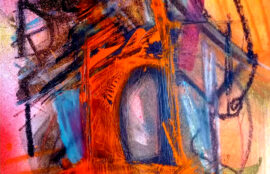


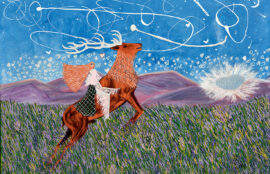






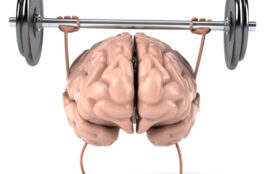



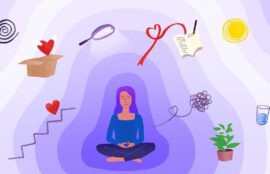





Sorry, the comment form is closed at this time.